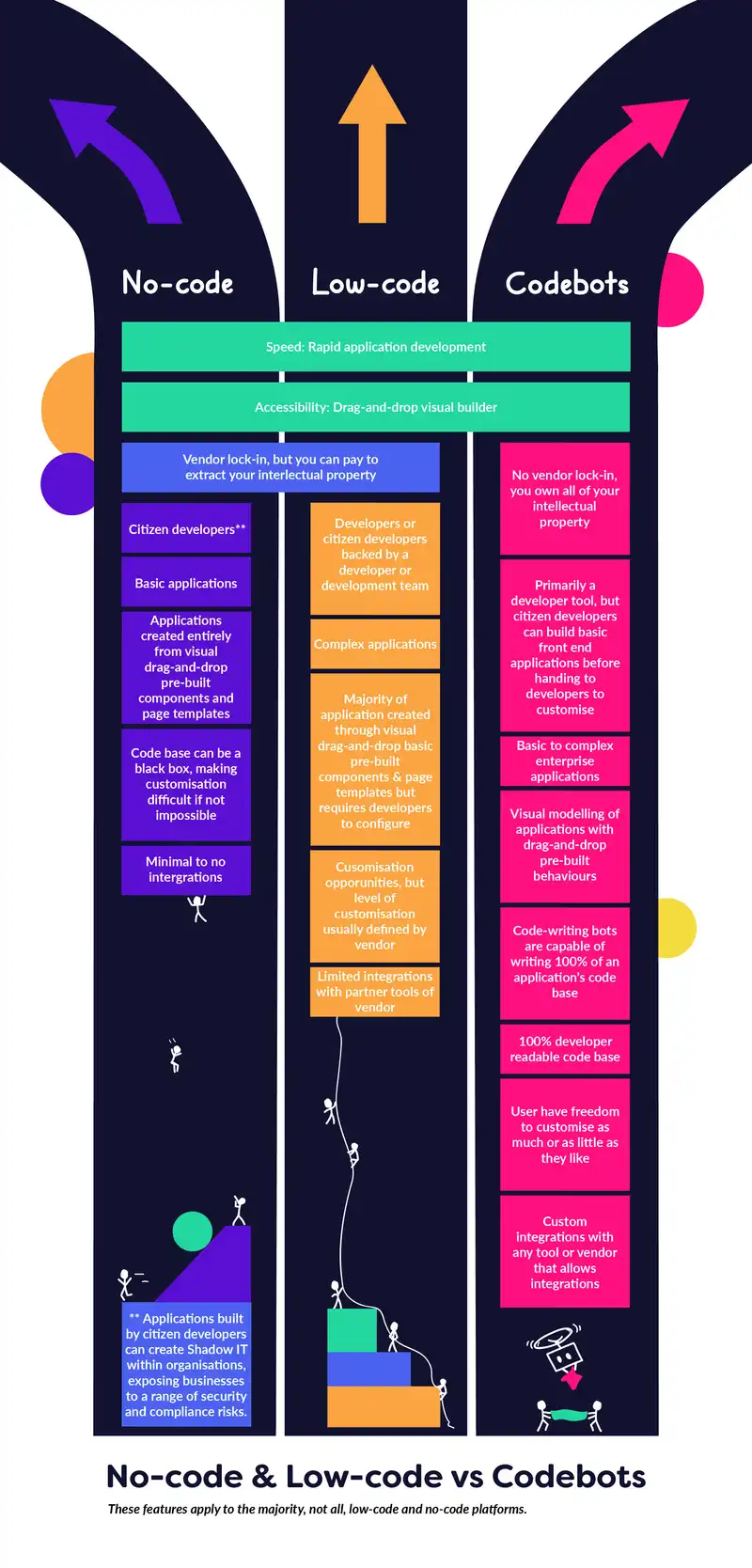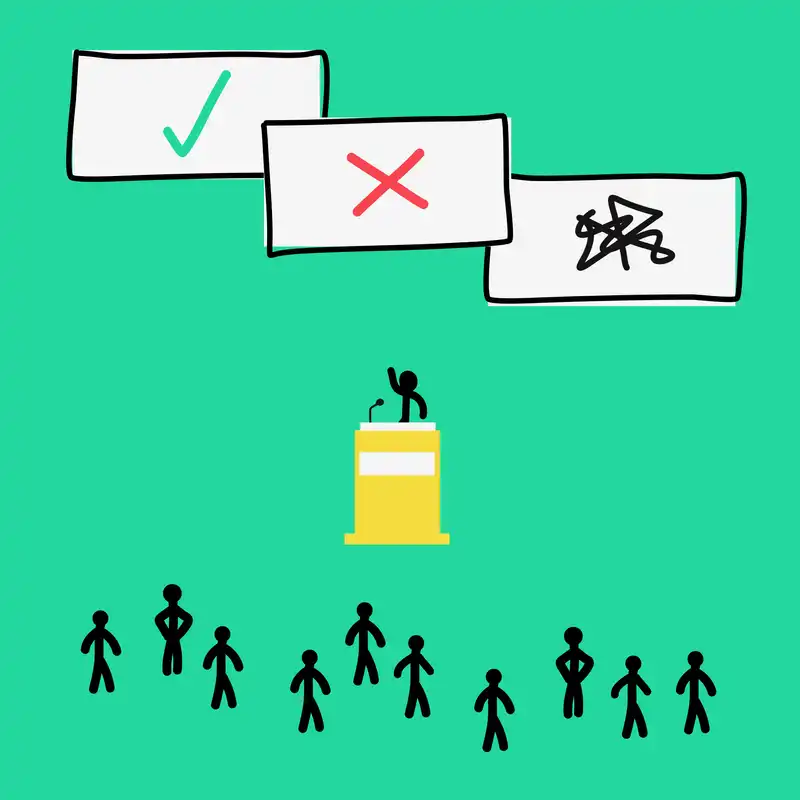Automation is having a powerful impact on our world. Through use of automation, businesses across all industries have reported higher production rates, increased productivity, more efficient use of materials, better quality products, and improved safety.
Automation in software development has led to the creation of various rapid application development tools. Low-code and no-code development platforms were the first generation to emerge, making software development faster and more accessible. Now, a new generation of rapid application development tools - like Codebots - are emerging, and their capabilities stretch beyond the limiting definitions of “low” and “no” code.
In this article, we will explore the benefits and limitations of low-code and no-code development platforms, and assess how they stack up against the new generation of rapid application development tools.
What are low-code and no-code platforms?
Low-code and no-code platforms are part of the early generation of rapid application software development tools. As technology began to mature, businesses of all sizes and industries realised they needed to undergo a digital transformation. In order to remain relevant and compete in the digital world, they needed software, websites, and/or applications that fit the experience consumers were now coming to expect.
Traditional software development was expensive, time-consuming, and required continuous maintenance. Projects would frequently run over budget or experience delays for a variety of reasons, including inaccurate estimations, infrastructure issues, code errors or testing challenges. For small businesses that work with strict budgets, traditional IT was simply unrealistic.
Low-code and no-code platforms emerged as a solution, boasting benefits of speed, affordability, and most importantly, accessibility to the masses.
Low-code and no-code platforms work by using visual modelling software to build applications. Users have access to a library of pre-built functionality they can drag-and-drop on a graphic interface, creating whole applications from templates that include general business processes and logic.
Low-code vs no-code: what’s the difference?
The key differences between low-code and no-code platforms are their target users and their output capabilities.
Low-code platforms primarily target developers, enabling them to rapidly build working front-end prototypes in a matter of days, or even hours. This allows them to get to the most interesting part of software development much faster: customisation. Low-code platforms are suitable for the creation of more complex applications and processes that require integration with other application databases or systems.
No-code platforms target the smaller businesses, those without the budget to outsource development, or hire a developer internally. Using a no-code platform, a citizen developer can create and deploy complete applications without needing to write a single line of code. The downside of this speed, ease and simplicity, is that no-code platforms are only really capable of developing basic applications that don’t require integration with any other systems. They may help to simplify a manual internal process, but they simply don’t have the capabilities to develop competitive, innovative software.
Problems with low-code and no-code development.
Low-code and no-code platforms have been extremely beneficial in starting the movement to make software more accessible to the masses. As with all new ideas however, there are a number of key issues that continuously frustrate and torment users.
When you work with a low-code or no-code platform, you and your software are at mercy of the vendor. You are locked in, and it is very difficult, in many cases impossible, to pack yourself up and move your software somewhere else. This is because these platforms retain ownership of users’ source code. So if you build on a platform and your software grows beyond the capabilities of that platform, or the platform doesn’t adequately cater to your business’ needs, you are forced to either adapt to fit the vendor’s capabilities, or to start over from scratch.
Some low-code and no-code vendors will allow you to buy your intellectual property from them, usually at a hefty price, but what you receive is generally a black box of unusable machine gibberish that would take a developer an unfathomable amount of time to decipher and translate into a manageable code base.
Along with these major platform flaws, low-code and no-code platforms present additional complications by dictating the systems you can integrate with, where you can host your software, the programming languages you can write in, and what you can actually customise.
As the rapid application development space continues to mature, low-code and no-code platforms and the limitations that come with them will soon become legacy. There is a new generation of rapid application development platforms emerging that don’t quite fit the boundaries of low-code or no-code definitions, seeking to address and eliminate key problems with these first generation tools.
The new generation of rapid application development tools.
Codebots is among the pioneers of the new generation of rapid app development tools. While low-code and no-code platforms emphasised accessibility and speed, platforms like Codebots are taking this to the next level, emphasising freedom and control.
We’ve explored the key problems and limitations of low-code and no-code platforms in the previous section. Codebots and others in this space are eliminating these problems, taking the power away from vendors and giving it back to the users. Logically, if these tools are designed to make life easier for people, doesn’t it make sense that people have ultimate control? Think of low-code and no-code platforms as a hierarchy, where the platform vendors sit on the throne and orchestrate the rules that impact all possible outcomes.

Using Codebots, users are empowered to choose their own adventure. Codebots users can choose which programming language they want to work with, where they want to host their software, and exactly how much they want to customise and hand-code. Users have ultimate control over what is possible, and total ownership of all the intellectual property they create.
Furthermore, this new generation of rapid application development tools goes beyond telling you ‘what’ you can do, educating users on ‘how’ they can do things. The Codebots platform hosts a Library and Academy with resources and qualifications covering everything you need to know to create polished, enterprise applications. Users can upskill as they work, which is particularly advantageous in bridging the technical knowledge gap between software and business developers.
What is the future of low-code and no-code platforms?
The rigidness of low-code platforms indicates that unless they start to continuously modernise their software to align with changing user demands, they will be unable to compete with new generation rapid application development tools. For empowered citizen developers however, no-code platforms may still have a space in the market. The ability to create a complete application without writing a single line of code is still useful in instances where speed is the primary priority.
Recently, public officials and government agencies in New York City recently used a no-code platform to build and launch a COVID-19 crisis-management platform in 72 hours. The solution identified and mapped virus hot spots, connecting residents to critical services. This example reflects the immense value of rapid development in times of crisis, where speed and data sharing are crucial.
For organisations that don’t have an IT team, or the budget to outsource a developer, no-code platforms are an affordable method for creating simple applications that streamline workflows or processes. That being said, there is only so much a citizen developer can do in a meaningful way. True innovation comes when people are given the power and tools to create beyond that which can be automated.
Platforms like Codebots enable users to embrace the power of automation, where bots take care of the monotonous, heavy lifting and give developers the ability to focus their capacity on creativity and complex problem solving.
Will rapid application development tools replace developers?
Despite the increasing sophistication of rapid application development tools, software developers are far from becoming obsolete. Automation tools do not replace developers, but rather, break down the limitations of what they can achieve, which increases their value and enhances their experience. By bypassing the tediousness of manually coding the same things over and over again, developers have the space to create more meaningful and innovative solutions.
This is the vision that founded Codebots; to create a space where humans and bots could work together to create solutions that previously wouldn’t have been thought possible. While we value and enable the ideal rapid application development standards of speed, quality, scalability, and reusability, our greatest triumph is putting freedom and control back into the hands of the users (yes, that means you own your source code and it’s 100% developer readable!).
Experience it for yourself. Sign up for a free trial now.




